An Article for World Osteoporosis Day - 20 October 2022
By Rebekah Rotstein and Lisa Jackson, Buff Bones®
When you think of osteoporosis, typically elderly clients come to mind. But 66% of Australians over 50 have osteoporosis or osteopenia (low bone mass that’s the precursor to osteoporosis). And since bone loss increases dramatically at menopause, your mid-life clientelle should be center stage in your mind, focusing on key elements to protect their bones.
Osteoporosis is often referred to as a “silent disease” since many people don’t even realize they’re losing bone mass. There is no pain associated with bone loss, nor any real visible signs of osteoporosis, until fractures start occurring. This is one reason why osteoporosis is a major concern for our health system and a key reason to advocate for exercise as a prevention tool. Once a person suffers an osteoporotic fracture, the chances of further fractures increase, which dramatically changes quality of life. A recent study of more than 35,000 Swedish women aged 55 to 90 found that within 24 months of an osteoporotic fracture, the incident of another fracture increased 11%.
Keep in mind that you may hear clients say that they don’t have osteoporosis, but in fact if someone breaks a bone from a standing height or below, that’s considered a fragility fracture, and osteoporosis is the diagnosis – regardless of their bone density score.
What do our bones need to stay strong and healthy?
Bones adapt to outside forces like gravity and weights by reinforcing themselves to handle similar loads in the future. This is why weight-bearing exercises and additional resistance are so important to bone health. Impact from jumping or stomping stimulates the bones as well and is key in building bone density. And to answer your next question, no, the jumpboard does not count for this since gravity is removed from the equation! That said, the jumpboard can be very useful for training muscle strength and force coupling (muscle teamwork), coordination and endurance. Improving balance and coordination also protects bones from fractures by preventing falls, and this may also decrease a person’s fears associated with osteoporosis.
While bone density is the most widely used diagnostic measure of osteoporosis and fracture risk, research has revealed its shortcomings where many people without a bone density classification of osteoporosis experience fragility fractures. Other factors that research has linked to fracture risk include performance or fitness aspects like lower extremity and back strength, static and dynamic balance, gait speed in addition to previous fracture history.
A 2021 study in Queensland comparing a high intensity resistance and impact training to a low intensity control (Buff Bones® – a bone health method using Pilates along with other modalities) found no bone density improvement in the low intensity group, whereas the high intensity group improved in the spine, although not in the hip. Yet it found statistically significant improvement in the low intensity group for muscle strength and functional performance.
So how can we help in our studios?
It shouldn’t be an either-or scenario of Pilates vs gym training. Both have their role. Our clients don’t need to quit their love of Pilates to run for the gym looking for higher loads. We can easily adapt our programming with higher spring loads and additional weights in sessions to help fortify their skeletons, while retaining the beloved elements of Pilates they love.
That said, one key unique element we can offer in a Pilates studio is teaching solid foundational movement with good motor control. This should always remain the first step before throwing in outside forces, higher load levels and challenging combinations. Progressions should still remain key and our clients will receive far greater benefits working from a balanced neuromyofascial system with sound joint control and alignment.
This is essential to avoid injury, especially considering the comorbidities that occur in this population with tendencies toward other existing conditions. It is not uncommon for peri- to post-menopausal women to experience tendon-related issues, particularly in the shoulders and hips.
What should we include in Pilates programming?
Foundations
Consider commonly taught pre-Pilates exercises which teach our clients about deep muscle recruitment and control through the joints and provide a solid amount of low level load required for maintaining good postural control. Breathing is crucial for deep core support and dynamic stability along with the ability to disassociate at the hip (the Hip Hinge is fundamental in the Buff Bones® programming). Upright squats are ideal, along with quadruped work to load the wrists. Challenging balance is also important and can be as simple as standing on one leg with eyes closed or moving the free limbs.
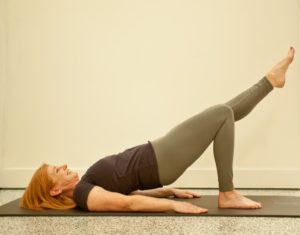
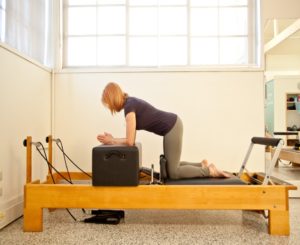
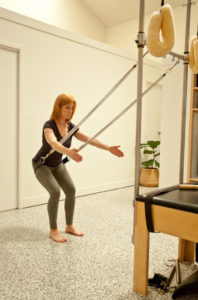
Target areas for strength and balance
The three most important areas to target are the spine, hips and wrists as these areas are the most prone to fracture. Apply hip and lower extremity work in upright positions and ensure you teach spinal extension exercises that emphasize the upper thoracic area and the muscles between the scapulae.
Standing work with the Reformer and the Wunda Chair are some of your go-to exercises (like scooter, standing abduction/skating, standing leg press, step up, mountain climber) as they provide not only strength and conditioning for the spine and hips but also deliver balance and coordination challenges. Be sure to offer stable options for unstable clients to hold onto! As your client progresses you can find ways to integrate hand weights.
Take advantage of the various props around your studio to challenge balance through soft surfaces to stand on and unsteady – yet safe – environments to practice in. Consider use of the foot and ankle to stimulate receptors for stability and their relationship to the entire kinetic chain.
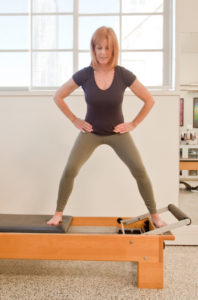
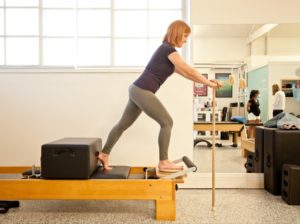
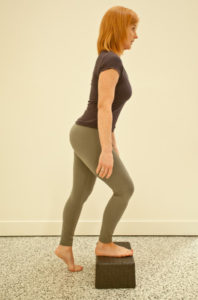
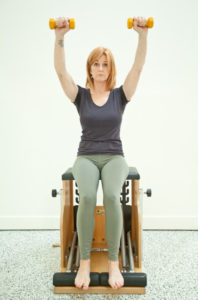
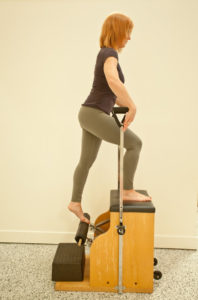
What to avoid
To further prevent injury, clients with osteoporosis and osteopenia should limit thoracic flexion and specifically avoid loaded flexion and end range spinal rotation. In case you’re thinking, ‘that’s a majority of the Pilates matwork!’, you’re right. But there are creative ways to modify a number of the exercises and alternatives to offer instead. Bands and balls can be added to assist and challenge as needed. And the Pilates apparatus enables tons of exercises where the springs provide ample opportunity to work in a safe and strengthening manner.
Midlife is an overlooked stage where interests differ greatly from early in careers as well as senior living. Providing the right Pilates tools and proper guidance to keep clients strong, safe and supple should be a primary focus for all of us.
For more information on bone health, visit www.buff-bones.com.
Rebekah Rotstein is the American founder of Buff Bones® and Lisa Jackson is the Australian faculty. They’ve trained instructors around the world in the method since 2011.
The authors:
Rebekah Rotstein, NCPT
Founder, Buff Bones®
@gotbuffbones
@rebekahrotstein
Lisa Jackson
Principal Trainer PAA
Adv.Dip Pilates
Training Faculty, Buff Bones®
@lisajacksonpilates
www.lisajacksonpilates.com.au

Comments are closed.